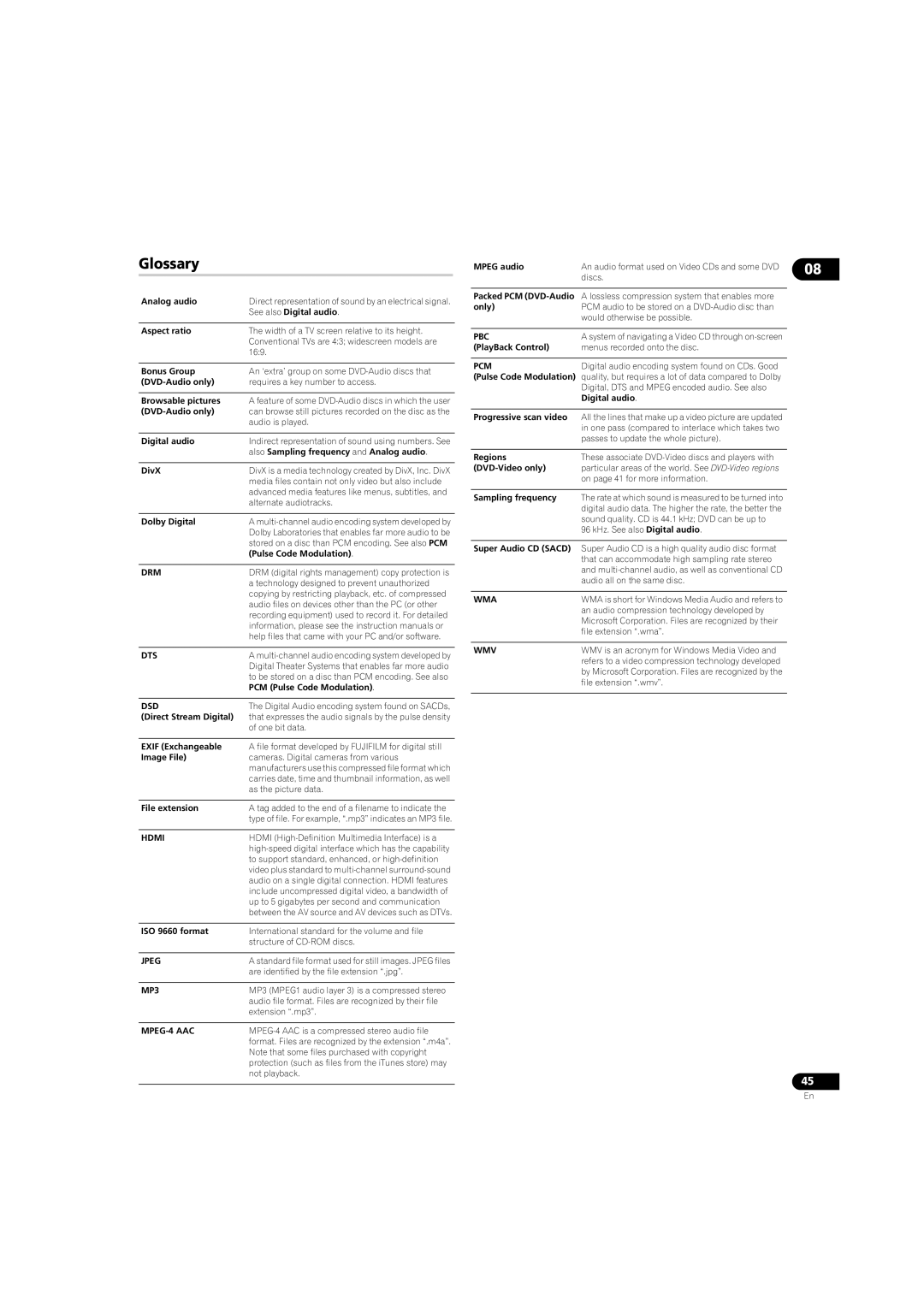
Glossary
Analog audio | Direct representation of sound by an electrical signal. |
| See also Digital audio. |
|
|
Aspect ratio | The width of a TV screen relative to its height. |
| Conventional TVs are 4:3; widescreen models are |
| 16:9. |
|
|
Bonus Group | An ‘extra’ group on some |
requires a key number to access. | |
|
|
Browsable pictures | A feature of some |
can browse still pictures recorded on the disc as the | |
| audio is played. |
|
|
Digital audio | Indirect representation of sound using numbers. See |
| also Sampling frequency and Analog audio. |
|
|
DivX | DivX is a media technology created by DivX, Inc. DivX |
| media files contain not only video but also include |
| advanced media features like menus, subtitles, and |
| alternate audiotracks. |
|
|
Dolby Digital | A |
| Dolby Laboratories that enables far more audio to be |
| stored on a disc than PCM encoding. See also PCM |
| (Pulse Code Modulation). |
|
|
DRM | DRM (digital rights management) copy protection is |
| a technology designed to prevent unauthorized |
| copying by restricting playback, etc. of compressed |
| audio files on devices other than the PC (or other |
| recording equipment) used to record it. For detailed |
| information, please see the instruction manuals or |
| help files that came with your PC and/or software. |
|
|
DTS | A |
| Digital Theater Systems that enables far more audio |
| to be stored on a disc than PCM encoding. See also |
| PCM (Pulse Code Modulation). |
|
|
DSD | The Digital Audio encoding system found on SACDs, |
(Direct Stream Digital) | that expresses the audio signals by the pulse density |
| of one bit data. |
|
|
EXIF (Exchangeable | A file format developed by FUJIFILM for digital still |
Image File) | cameras. Digital cameras from various |
| manufacturers use this compressed file format which |
| carries date, time and thumbnail information, as well |
| as the picture data. |
|
|
File extension | A tag added to the end of a filename to indicate the |
| type of file. For example, “.mp3” indicates an MP3 file. |
|
|
HDMI | HDMI |
| |
| to support standard, enhanced, or |
| video plus standard to |
| audio on a single digital connection. HDMI features |
| include uncompressed digital video, a bandwidth of |
| up to 5 gigabytes per second and communication |
| between the AV source and AV devices such as DTVs. |
|
|
ISO 9660 format | International standard for the volume and file |
| structure of |
|
|
JPEG | A standard file format used for still images. JPEG files |
| are identified by the file extension “.jpg”. |
|
|
MP3 | MP3 (MPEG1 audio layer 3) is a compressed stereo |
| audio file format. Files are recognized by their file |
| extension “.mp3”. |
|
|
|
|
| format. Files are recognized by the extension “.m4a”. |
| Note that some files purchased with copyright |
| protection (such as files from the iTunes store) may |
| not playback. |
|
|
MPEG audio | An audio format used on Video CDs and some DVD | 08 |
|
discs.
Packed PCM | A lossless compression system that enables more |
only) | PCM audio to be stored on a |
| would otherwise be possible. |
|
|
PBC | A system of navigating a Video CD through |
(PlayBack Control) | menus recorded onto the disc. |
|
|
PCM | Digital audio encoding system found on CDs. Good |
(Pulse Code Modulation) | quality, but requires a lot of data compared to Dolby |
| Digital, DTS and MPEG encoded audio. See also |
| Digital audio. |
|
|
Progressive scan video | All the lines that make up a video picture are updated |
| in one pass (compared to interlace which takes two |
| passes to update the whole picture). |
|
|
Regions | These associate |
particular areas of the world. See | |
| on page 41 for more information. |
|
|
Sampling frequency | The rate at which sound is measured to be turned into |
| digital audio data. The higher the rate, the better the |
| sound quality. CD is 44.1 kHz; DVD can be up to |
| 96 kHz. See also Digital audio. |
|
|
Super Audio CD (SACD) | Super Audio CD is a high quality audio disc format |
| that can accommodate high sampling rate stereo |
| and |
| audio all on the same disc. |
|
|
WMA | WMA is short for Windows Media Audio and refers to |
| an audio compression technology developed by |
| Microsoft Corporation. Files are recognized by their |
| file extension “.wma”. |
|
|
WMV | WMV is an acronym for Windows Media Video and |
| refers to a video compression technology developed |
| by Microsoft Corporation. Files are recognized by the |
| file extension “.wmv”. |
|
|
45
En
